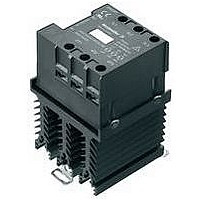8952130000 Weidmuller, 8952130000 Datasheet - Page 6

8952130000
Manufacturer Part Number
8952130000
Description
SSR, DIN RAIL, 520VAC, 30VDC/30VAC, 20A
Manufacturer
Weidmuller
Datasheet
1.8952110000.pdf
(142 pages)
Specifications of 8952130000
Control Voltage Type
DC
Control Voltage Range
8VDC To 30VDC / 10VAC To 30VAC
Operating Voltage Range
24VAC To 520VAC
Peak Surge Current
250A
Load Current
20A
Switching Mode
Zero Cross
Rohs Compliant
No
- Current page: 6 of 142
- Download datasheet (8Mb)
C
Relays – overview
Relays – overview
Switching large and small capacities
Basically, the reliability of the contacts in a relay reaches a
maximum at a medium current load thanks to the continuous
self-cleaning effect. As the contact load increases and hence
leads to more severe erosion of the contacts, the switching
reliability decreases with an increasing number of switching
operations. This reduces the service life of the contacts.
Although at very low loads the minimal erosion of the contacts
does raise the service life more or less to the level of the
mechanical service life, the lack of a self-cleaning effect
contributes to a lower contact reliability.
Reliable contact at low currents, especially when only small
voltages are involved as well, depends on the choice of contact
material. Contacts of silver-nickel, which is standard for the
majority of Weidmüller relays, are generally suitable for currents
of approx. 10 mA and higher. Such large-surface contacts can
switch both low and high currents. However, at low currents
occasional failures can occur due to erosion and the lack of the
self-cleaning effect. The higher the current, the more reliable is
the contact – thanks to the self-cleaning. Silver-nickel is suitable
as a contact material for low currents/voltages. It provides,
however, only moderate switching reliability. If this is
acceptable, then conventional standard relays represent an
inexpensive solution.
For applications that call for improved contact reliability or
low currents/voltages, conventional relays with hard-plated
gold contacts are preferable because they do not erode and
therefore operate more reliably.
If maximum switching reliability is necessary, especially for
low currents/voltages, a relay should not be your first choice.
In these instances Weidmüller advises the use of optos.
Wear and abrasion caused by mechanical movements are
non-existent in optos.
C.6
Protective circuits for the contacts
The switching of inductive or capacitive loads produces
switching sparks which can influence the electrical service life
of the relays. The following protective circuits for the contacts
reduce contact wear:
Diode
Advantage:
Disadvantage:
Diode and Z-diode
Advantage:
Disadvantage:
Varistor
Advantage:
Disadvantage:
RC combination
Advantage:
Disadvantage: Cannot be used for all operating voltages and
U S = Voltage progression
(~)
(~)
–
–
–
–
load
load
load
load
(~)
(~)
+
+
+
+
capacities
Short release delay, low price
VDR
R
C
Can be used for all capacities, low surge,
minimum space required, low price
Very long release delay
Low surge (defined by Z-diode),
short release delay
Cannot be used for large capacities
Low surge, short release delay
High current load on the contacts when
switching on; more complicated and expensive
at greater capacities
U
U
U
U
ZD
D
VDR
RC
U
U
U
S
U
S
S
S
1
1
1
1
1 = Closing
2
2
2
2
t
t
t
t
2 = Opening
Related parts for 8952130000
Image
Part Number
Description
Manufacturer
Datasheet
Request
R

Part Number:
Description:
STANDARD I.C. PIN
Manufacturer:
Mill-Max Manufacturing Corp.

Part Number:
Description:
MK 3/6
Manufacturer:
Weidmuller
Datasheet:

Part Number:
Description:
SL 5.08/7/90 3.2SN OR Omnimate Range 5.08
Manufacturer:
Weidmuller
Datasheet:

Part Number:
Description:
SL 5.08/18/90 3.2SN OR Omnimate Range 5.00/5.08
Manufacturer:
Weidmuller

Part Number:
Description:
SL 5.08/24/90 3.2SN OR Omnimate Range 5.00/5.08
Manufacturer:
Weidmuller











